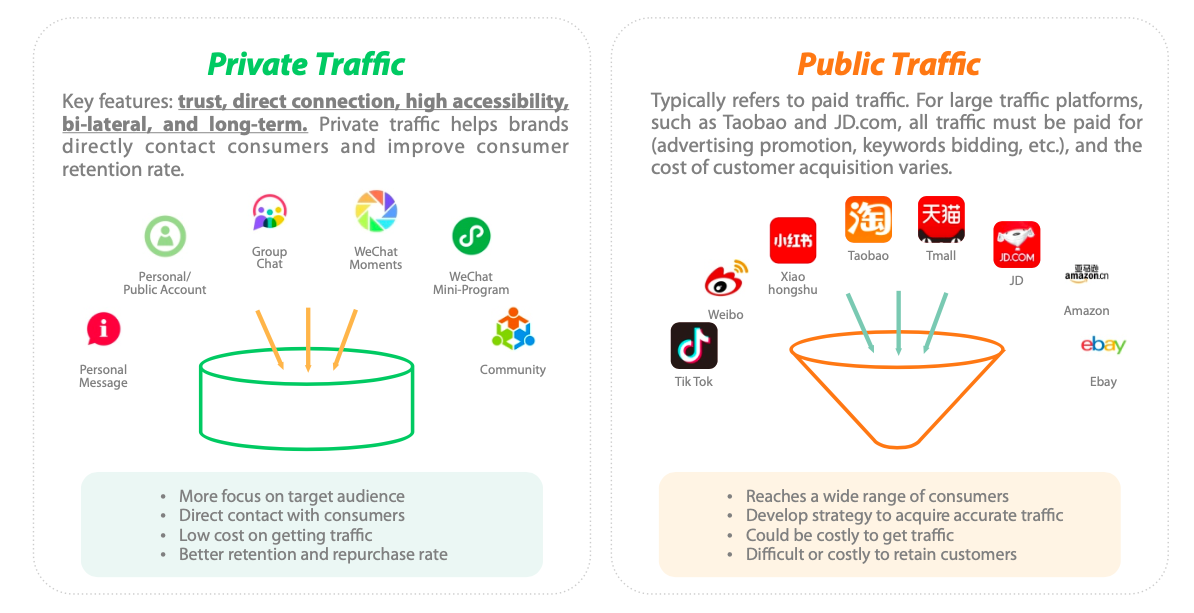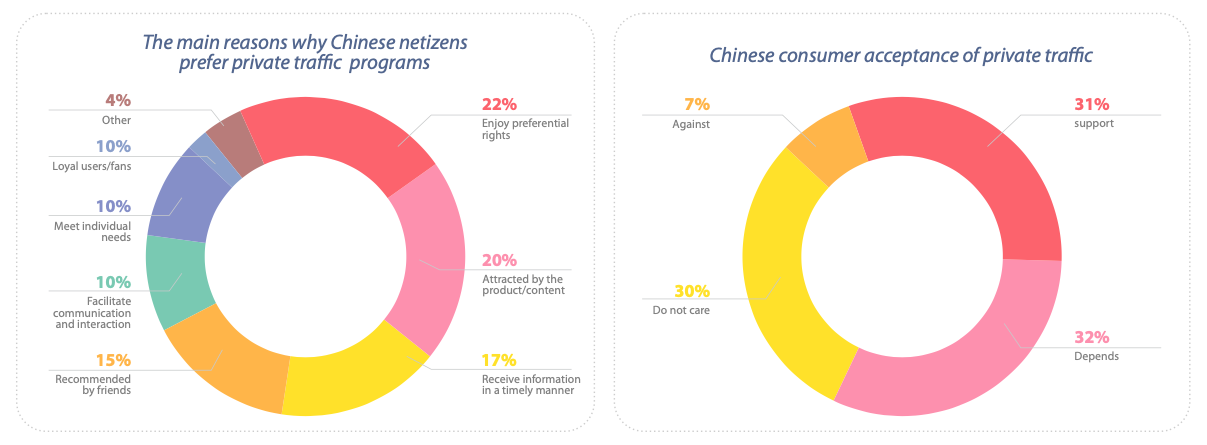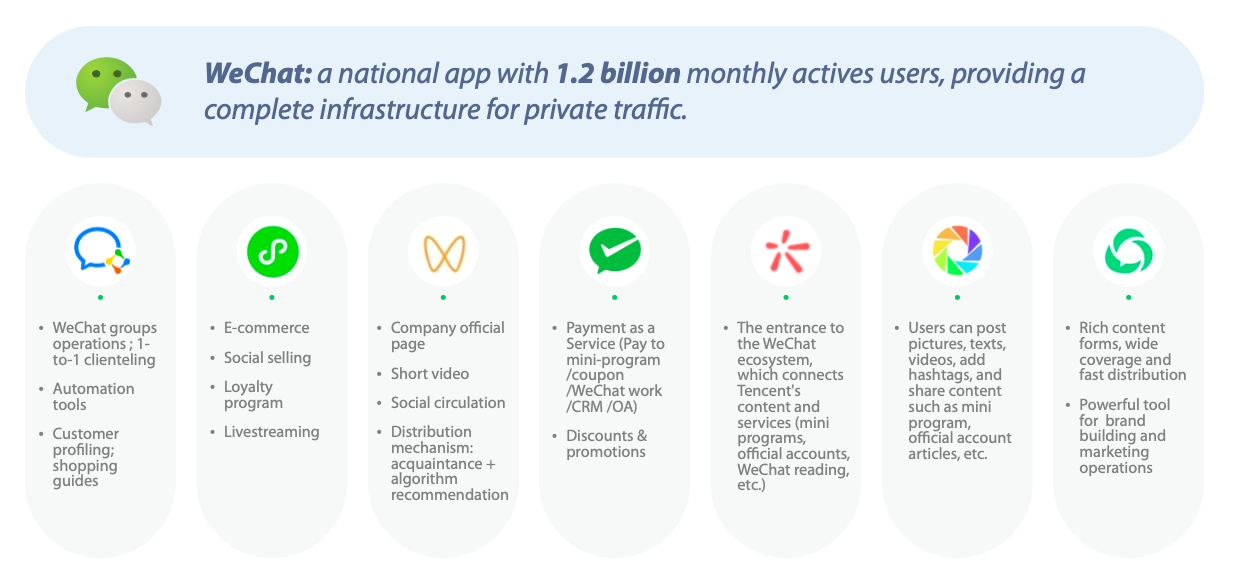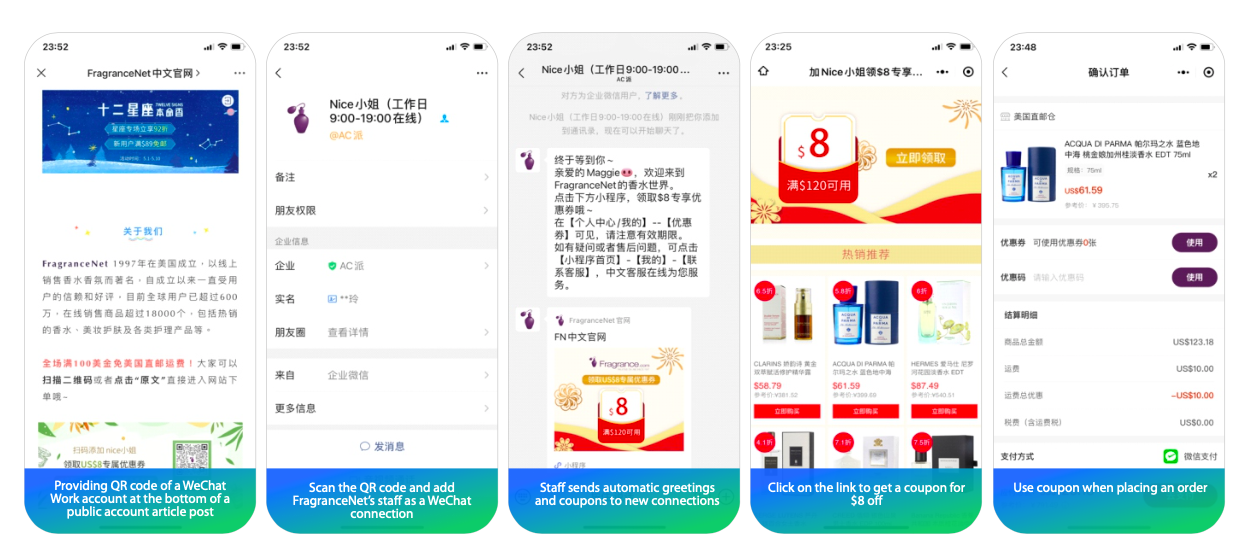Private Traffic -- Why It’s a China Marketing Buzzword?
by Maggie Yu
As attracting online traffic becomes more and more expensive in China, the term ‘private traffic’ (私域流量) has emerged as a top marketing buzzword. The Western equivalent of private traffic would be a blog or an email list, which are owned channels. However, in China, people rarely visit websites or use email, so retailers and brands have begun seeking ways to “own” their customer base by creating private traffic on social media sites.
What is Private Traffic?
Private Traffic refers to communications with customers being funnelled into a database, where brands can have full control with limited or no costs. Examples of popular social platforms in China that generate private traffic include WeChat Official Accounts, WeChat Work Group, WeChat Moment and WeChat Mini Program, and other messaging-based platforms like QQ.
Public Traffic is also called platform traffic. It does not belong to a single individual but is the traffic shared by the collective. For large traffic platforms such as Chinese online shopping platforms Taobao and JD.com, brands and retailers must pay for all traffic (through banner ads and visibility ranking promotions, for instance), and the price keeps rising.

Why private traffic matters now?
Compared with Taobao and JD.com public traffic platforms, private traffic belongs to brands’ or businesses' "private assets." Establishing a private traffic pool can help a brand reach customers easier and at a lower cost. Here are four major advantages for brands:
(1) Reduced customer acquisition costs: Due to the gradual maturity and stability of Internet development, the cost of customer acquisition is very high. According to a recent report, the cost of acquiring a new user on the Internet platform is 5-10 times that of maintaining an existing user. Alibaba’s average customer acquisition cost increased from 12.17 yuan ($1.90 US) per person in 2013 to 146.15 yuan ($22.85 US) per person in 2020.[1] Although customers brought by the brand through paid traffic have made a purchase, they do not have more interaction with the brand. Next time, the brand still needs to pay a high amount of publicity expenses to promote the product. Conversely, in the private traffic pool, consumers are loyal to the brand. Therefore, when the brand launches new products and activities, private traffic is a free, high-quality promotion platform for the brand.
(2) Enhanced customer loyalty: Consumers are easily attracted to lower-priced or higher-quality products. Suppose brands can gather consumers in their own private traffic pools through promotion activities, interacting with consumers, livestreaming, and other forms of digital marketing. In that case, it can connect the brand and customers beyond product sales. When the brand establishes emotional connections and interactions with consumers, brand loyalty and repeat purchase rates rise.
(3) Increased brand value and brand awareness: Brands can build private traffic pools to allow consumers to feel closer to the brand. Consumers can communicate with others, directly enhancing brand awareness from word-of-mouth recommendations, thereby forming brand impressions and continuously improving brand value.
(4) Higher customer stability, and reduced customer churn: Private traffic can effectively solve the customer attrition problem. Whether for new or existing consumers, private traffic can effectively promote communication and reinforce customer loyalty.
Consumer willingness to join private traffic pools in China

Recent research found that 40.8% of customers entered the marketing party’s private domain because they could enjoy preferential rights, and 37.8% of customers were attracted by the marketing party’s products or content. Providing preferential prices and featured products or content is the easiest way for marketers to impress users and gain followers.[2]
| Download our 66-pg Private Traffic Report to learn how to retain & capitalize on your customer database in China via private traffic. learn how to retain & capitalize on your customer database in China via private traffic. |
How does private traffic work on the WeChat ecosystem?
WeChat is a wildly popular mega-app with 1.2 billion monthly active users, providing a complete infrastructure for private traffic. According to Sensors Data, the average daily usage of the WeChat ecosystem accounts for more than 20%, which means that WeChat accounts for nearly one-fifth of the users’ daily usage frequency of mobile products.[3] This kind of ecology strongly related to lifestyle habits enables brands to naturally access a vast traffic base right away, and the coverage capacity is still improving.

WeChat Work can help retail companies efficiently manage and maintain customers by adding customer WeChat and other connectivity capabilities. At the same time, it provides applications such as WeChat Group and sign-in to strengthen the interaction between brands and users. The weChat group is a format of traffic pool for retailers with a maximum of 500 people in a group. Group admin will manage the group every day, and regularly send group status, new arrivals, group announcements, and topic interaction with users to improve group activity and user stickiness.
WeChat Moments is the entrance of fission sharing – word-of-mouth marketing and viral communication – in private traffic and the main position of brand advertising. More importantly, with the systematization of WeChat Work operations, more and more brands have begun to create exclusive Moments displays and IPs for customers for one-on-one personalized service (like fictional virtual influencer “Xiao Wanzi” of Perfect Diary).
WeChat Official Account can let brands build the official account and release branded content like the brand story and promotional information. It helps brands increase customer engagement through interactive campaigns, customer benefits, and coupon distributions. Brands also embed Mini Program, WeChat Work QR codes and more to convert content into sales or group operations.
WeChat Mini Program was launched in January 2017. Most mini-programs can be developed quicker than downloadable apps. Users can access mini-programs without having to install or download them. As of June 2020, the number of monthly users of the WeChat Mini-Programs has reached 830 million, up 11.6% from 2019. Consumers use mini-apps for online shopping, customization, collecting coupons, ordering food delivery, booking movie tickets, booking taxis, and many more daily services.
WeChat Channel is the proprietary short video platform of WeChat. Its main difference is its capability to recommend content based on a user’s social network. WeChat Channel videos can be shared through chat windows, WeChat article posts, or WeChat Moments. Short video usage is on the rise, and WeChat Channel videos are easily shared from peer to peer. WeChat Channels can be linked with Official Accounts and Mini Programs to increase the rate of content seeding to buying. It also provides another route for branded content to reach beyond the private domain of a brand and foray into a customer’s social network.
Real examples: How private traffic works in WeChat

This image shows how FragranceNet leverages the WeChat ecosystem to attract traffic and build a community independently to promote conversions. At first, FragranceNet put their WeChat Work account QR code at the bottom of a public account article. Users who scan this QR code can add FragranceNet's staff (Miss Nice) as a WeChat contact, then Miss Nice will send greetings and coupons to new followers. Users click on the link to get the coupon and they can go to Mini Programs Mall to purchase to form a closed transaction loop.
Top 3 methods to manage customers via WeChat Work

Model 1: Group assistant
Customers like to join WeChat groups to acquire the latest information about promotional campaigns or participate in group discussions to learn more about new releases. Brands leverage the WeChat Work Group to share products using experience and promotions with consumers in the private traffic pool. This model meets customers’ demand for convenient access to rich information and special benefits.
Model 2: Group expert
Group expert is suitable for targeting consumer groups in the professional or lifestyle categories. It can attract individuals, who need a sense of belonging and relevant knowledge and improve customer’s stickiness. In the case of FragranceNet, the group expert would be like your friend, who can tell you which perfume to buy for gifting and recommend perfumes one-on-one.
Model 3: Personal consultant
The personal consultant model is usually suitable for luxury goods or education and fitness industries, whose customers need valuable and personalized services. The role is like the digital version of an advisor or consultant, who can provide personal guidance and exclusive advice.
How brands and retailers leverage private traffic
The essence of private traffic is user-centred. It digs deep into customer value and, through continuous user operations, it enhances user lifecycle value and helps brands achieve large-scale growth. Azoya concluded that there are 4 steps to build private traffic for retail businesses.
1. Reach users: Reach potential customers or existing customers via diverse communication methods, and invite them to follow or connect with you via WeChat Work or follow the account. For some high-value customers, brands should even consider calling them and inviting them to join.
2. Retain users: Ensure users are connected with you via social media or acquire users’ contact information to reach out to them again. Consider occasionally offering incentives such as coupons or vouchers.
3. Loyalty nurturing: Build a strategy to nurture your customers (sales leads) by adopting a personal IP, group expert, group admin, product seeding and content marketing to grow customer loyalty and create a sense of belonging.
4. Convert to sales: Run effective marketing campaigns to drive sales. Tailor-make sales campaigns based on group & individual personas and recency, frequency and monetary value (RFM) models. Offer exclusive campaigns to capitalize on private traffic value.
Will private traffic be the future trend of marketing?
Will private traffic be the future of marketing? The answer may be yes. When user attention is increasingly divided among major apps, private traffic can help brands build more vertical, efficient, and sticky customer acquisition channels. In the future, private traffic operations will evolve from the "icing on the cake" to a standard business essential as a cost-effective way for brands to fuel e-commerce sales and loyalty.
| Miss the memo? Download our latest Capitalize On WeChat Private Domain: Best Practice 2022 Now! |
[1] Eastern Fortune: The cost of acquiring customers is getting higher and higher, 2019; url
[2] iimedia Date Center: Interpretation of the development status and trends of China's private domain traffic, 2019; url
[3] Sensors Data: Panoramic Interpretation of Operations in WeChat Ecosystem, 2020; url